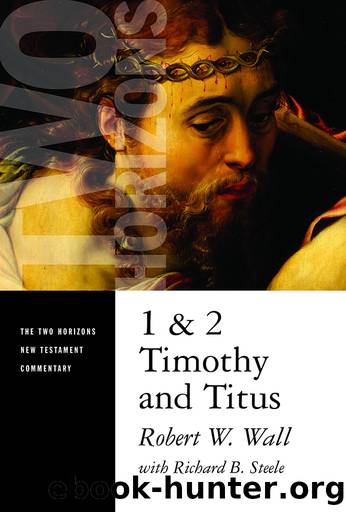1 and 2 Timothy and Titus by Robert W. Wall

Author:Robert W. Wall
Language: eng
Format: epub
Publisher: William B. Eerdmans Publishing Company
Case Study: John Wesley and the Early Methodist Societies
The aim of instruction is loving relationships that come from a pure heart, good conscience, and earnest faith. (1 Tim 1:5)
Early British Methodism instantiated some of the key themes that Paul develops in the Pastoral Epistles. John Wesley, the founder of Methodism, followed Pauline precedent in holding right doctrine (“orthodoxy”), right conduct (“orthopraxy”), and right character (“orthopathy”) in dynamic tension.1 This case study offers first an overview of the ecclesial structures that Wesley developed to form, inform, and transform his followers. It then delineates five specific ways in which early Methodist doctrine, practice, and experience embodied ideas embedded in 1 Timothy 1:1–20: (1) in the recognition that “healthy teaching” (1:10; cf. Tit 2:8) is crucial for the spiritual and moral welfare of the Christian community and that “divergent doctrine” is correspondingly destructive; (2) in the insistence that the aim of healthy teaching is to foster “loving relationships that come from a pure heart, good conscience, and earnest faith” (1:5); (3) in the affirmation that the law, that is, the moral teaching of Scripture, as interpreted and codified by the historic church, has a crucial role to play in the Christian life (v. 8); (4) in the belief that Christians who are growing spiritually and morally need “role models” to imitate (v. 16); and (5) in the conviction that Christ’s saving work is offered to all persons without exception (v. 15) and therefore that the internal dealings and external mission of the church, God’s “house-hold” (οἶκος θεοῦ, oikos theou, 3:15), must bear consistent witness to “God’s way of ordering the real world” (οἰκονομία θεοῦ, oikonomia theou, 1:4), such that “everyone [might] be saved and come to the knowledge of the truth” (2:4).
I do not claim that Wesley specifically used the Pastoral Epistles as a blueprint or formal constitution for the array of large-group and small-group structures he developed for the spiritual nurture of his followers. Wesley certainly believed that the theological principles he espoused and the spiritual and moral character and conduct he sought to foster in his disciples2 reflected scriptural norms, and, because the Pastorals represent the most thoroughgoing statement of church order in the NT canon, it is no surprise that many of the teachings and practices characteristic of early Methodism are consonant with Paul’s instructions to Timothy and Titus. But that does not mean that Wesley’s ecclesiastical experiments were driven primarily by his reading of the Pastorals. His understanding of “primitive Christianity” was funded from many sources, both biblical and sub-apostolic, and many of his most successful experiments in organizing the movement began as rough-and-ready responses to immediate problems or opportunities and were legitimized (at least in his eyes) by their worthwhile outcomes.
The overview of the structures of early Methodism given here is very brief and heavily dependent on more detailed accounts readily available in the scholarly literature.3 My aim here is simply to show how these structures functioned together to enable the early Methodists to live as the “household of God” (3:15).
Download
This site does not store any files on its server. We only index and link to content provided by other sites. Please contact the content providers to delete copyright contents if any and email us, we'll remove relevant links or contents immediately.
| Guides | New Testament |
| Old Testament |
The Five People You Meet in Heaven by Mitch Albom(3456)
Real Sex by Lauren F. Winner(2949)
Name Book, The: Over 10,000 Names--Their Meanings, Origins, and Spiritual Significance by Astoria Dorothy(2925)
The Secret Power of Speaking God's Word by Joyce Meyer(2920)
The Holy Spirit by Billy Graham(2877)
0041152001443424520 .pdf by Unknown(2768)
ESV Study Bible by Crossway(2725)
How The Mind Works by Steven Pinker(2712)
Ancient Worlds by Michael Scott(2607)
The ESV Study Bible by Crossway Bibles(2494)
Churchill by Paul Johnson(2493)
The Meaning of the Library by unknow(2485)
The Gnostic Gospels by Pagels Elaine(2459)
MOSES THE EGYPTIAN by Jan Assmann(2360)
City of Stairs by Robert Jackson Bennett(2294)
Jesus by Paul Johnson(2294)
The Complete Dead Sea Scrolls in English (7th Edition) (Penguin Classics) by Geza Vermes(2222)
Ancient Near Eastern Thought and the Old Testament by John H. Walton(2183)
The Nativity by Geza Vermes(2165)
